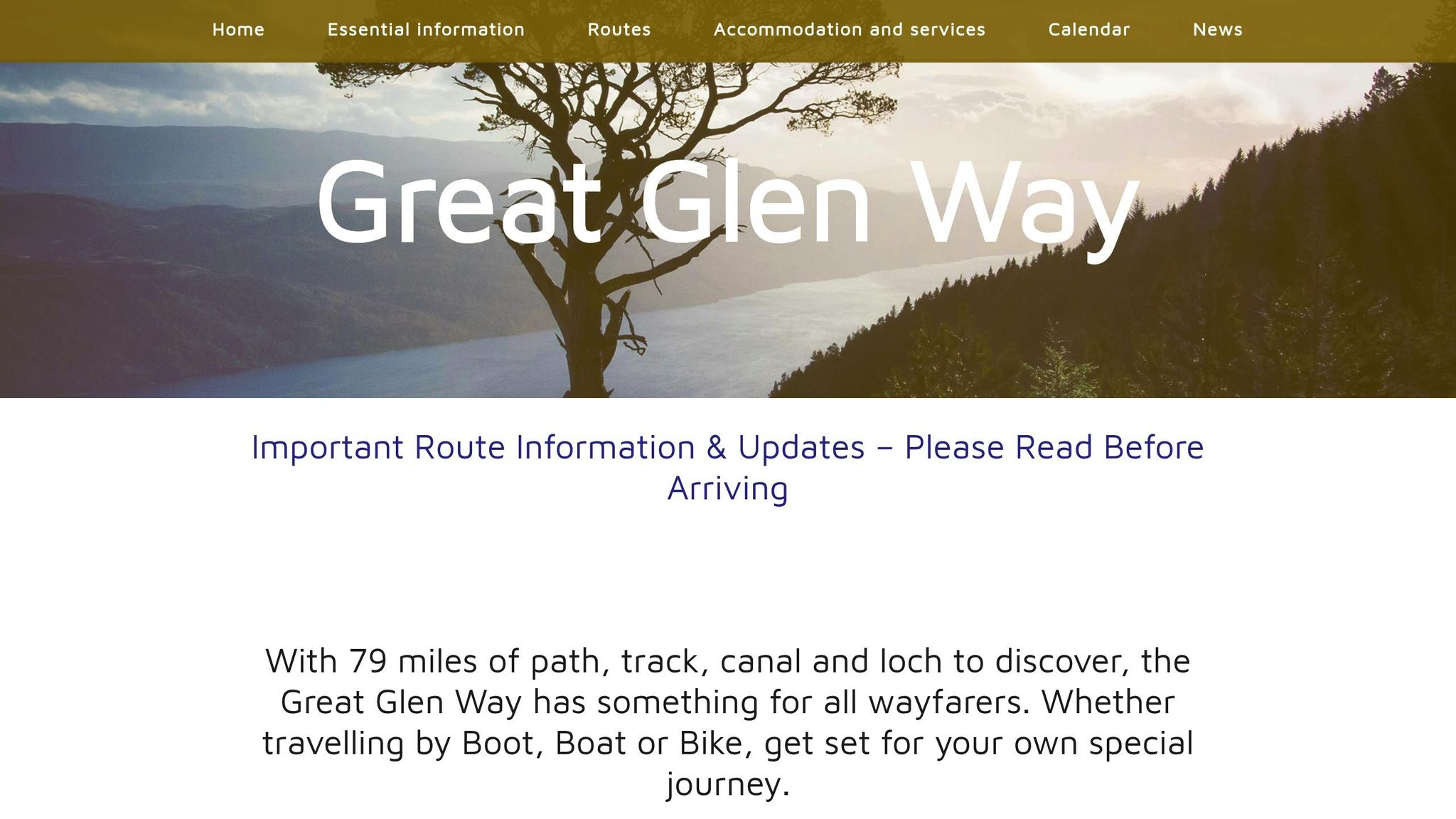Scotland is a hiker’s dream, offering trails for all skill levels across its diverse landscapes. Whether you’re scaling Munros, walking along serene coastlines, or exploring historic routes, there’s something for everyone. Here’s what you need to know:
- Top Trails: West Highland Way (96 miles), Ben Nevis (4,413 ft), Great Glen Way (79 miles), The Quiraing (Isle of Skye), and Cairngorms National Park.
- Best Time to Visit: May–August for long daylight hours; April for fewer crowds and drier weather.
- Essential Gear: Waterproof clothing, sturdy boots, maps, compass, and seasonal items like midge repellent.
- Safety Tips: Check weather forecasts, share your route, and stay on marked paths.
Scotland’s trails combine stunning views, rich history, and unique wildlife. Whether you’re a beginner or an experienced hiker, proper preparation ensures a safe and unforgettable adventure.
Before You Hike: Key Planning Steps
When to Hike in Scotland
Scotland’s best hiking season typically spans May through August. During this time, temperatures hover around 63°F (17°C), and you can enjoy up to 18 hours of daylight. If you’re looking to avoid crowds and those pesky midges, April might be a better choice, as it’s often drier than the peak summer months.
Here’s a breakdown of what to expect in each season:
Summer (June–August)
- Warm weather and the longest daylight hours, perfect for extended hikes.
- Expect more tourists and higher midge activity, especially in July and August.
- Inverness daytime highs average around 66°F (19°C).
Spring/Fall (March–May/September–November)
- Trails are less crowded, but the weather can be more unpredictable.
- April sees about 72 mm of rain on the Isle of Lewis.
- Fall is a great time to see vibrant seasonal colors.
Winter (December–February)
- Daylight is limited to about six hours.
- Conditions can be tough, requiring advanced hiking skills.
- Snow-capped peaks create breathtaking views.
- Stick to main roads in the Highlands for safety.
"Winter is one of the best times to visit Scotland if you are a keen landscape photographer. There are a few places where rugged mountains are so close to the sea, and the stark contrast between the stunning coastline dotted with beaches and the snow-capped peaks, especially along the west coast and on the Isle of Skye, can be great to capture." – Christoph Glauche, Scotland Travel Consultant
Once you’ve decided when to go, make sure you’re equipped for Scotland’s ever-changing weather.
Required Gear List
Being prepared with the right gear is crucial for a safe and comfortable hike in Scotland. Here’s what you’ll need:
Essential Clothing
- Waterproof jacket and overtrousers.
- Base layers made from synthetic materials or merino wool (avoid cotton).
- A fleece or thermal layer for added warmth.
- Sturdy hiking boots with ankle support.
- Gaiters to handle wet or muddy conditions.
- Warm gloves and extra socks.
Navigation & Safety
- A 25–40 liter rucksack.
- Physical map and compass.
- Waterproof case for your phone.
- Headtorch with spare batteries.
- Emergency whistle.
- First aid kit, including blister treatments.
- Survival bag.
Seasonal Extras
- Midge repellent and a head net (for summer months).
- Sunscreen and sunglasses during warmer weather.
- Additional warm layers for winter hikes.
Trail Safety Rules
Even with the right gear, sticking to safety practices is essential for a successful hike:
Pre-Hike Planning
- Check the Mountain Weather Information Service (MWIS) for up-to-date forecasts.
- Share your planned route with someone who can raise the alarm if needed.
- Confirm the daylight hours for your hike.
- Research the trail’s difficulty and terrain in advance.
During Your Hike
- Stick to marked paths whenever possible.
- Keep a safe distance from wildlife and farm animals.
- Control your dog around livestock.
- Pack extra food and water for longer hikes.
- Stay alert to changing weather conditions.
Navigation Safety
- Carry both digital tools and a physical map and compass.
- Keep magnetic items away from your compass to avoid interference.
- Make sure you know how to use your map and compass properly.
- Be ready to turn back if the weather takes a turn for the worse.
Top 10 Hikes in Scotland
sbb-itb-5a16d31
5 Must-Try Scottish Hiking Trails
With the right preparation, these five trails offer a chance to experience Scotland’s breathtaking landscapes and rich natural beauty.
West Highland Way: Complete Guide

Stretching 96 miles (153 km), the West Highland Way is one of Scotland’s most famous long-distance trails. This south-to-north route typically takes 6–8 days to complete, combining stunning scenery with a rewarding challenge.
Key highlights include:
- Loch Lomond’s picturesque views
- The historic Glencoe valley
- Rolling highlands and remote moorlands
Overnight options are available at King’s House or Glencoe village, accessible via a short bus ride. Convenient train links connect the trail to Glasgow and Fort William.
The Quiraing: Isle of Skye Trek
The Quiraing, located on the Isle of Skye, is known for its dramatic landscapes shaped by ancient landslips. This trail offers some of the island’s most stunning views and is a favorite for photographers.
What makes it special:
- Unusual geological formations
- Panoramic coastal views
- Opportunities to capture breathtaking scenery
Ben Nevis: Summit Guide
Standing at 4,413 feet (1,345 m), Ben Nevis is Scotland’s tallest mountain and a favorite for hikers seeking a challenge. The Mountain Track, starting at Glen Nevis, is the easiest route to the summit.
Details to know:
- Ascent time: 4–5 hours
- Total distance: 10.5 miles (17 km) round trip
- Summit features: Emergency shelter and navigation cairns
Want more adventure? Pair this climb with a trek along the Great Glen Way.
Great Glen Way: Fort William to Inverness

This 79-mile (127 km) trail winds through the heart of the Highlands, following the Caledonian Canal and the shores of iconic lochs. Typically completed in 5–6 days, the route offers a mix of canal paths and forest trails. Fort William serves as a great starting point and connects easily to Ben Nevis.
Highlights include:
- Loch Ness views
- Historic canal locks
- A mix of forested and mountainous terrain
Cairngorms Park: Top Trail Routes
Cairngorms National Park is a treasure trove of hiking opportunities, featuring ancient forests and expansive mountain plateaus. The park’s trail network caters to all skill levels, from gentle walks to more demanding climbs.
Popular routes include:
- Lairig Ghru mountain pass
- Rothiemurchus Forest trails
- The Cairn Gorm summit path
For all these trails, plan ahead for accommodations, especially during the busy summer months (June–August). Options range from simple bunkhouses to more comfortable hotels.
These trails invite exploration, offering not just stunning hikes but also opportunities for photography and local activities to enhance your journey.
Make the Most of Your Hike
Finding Local Hiking Guides
Hiring a professional guide can elevate your hiking experience by providing local insights and ensuring your safety. Scotland is home to several well-regarded guide services across its scenic hiking areas.
Hike Highlands offers personalized guided walks tailored to various skill levels. Their guides blend historical context with nature, adjusting routes to suit the group. One hiker shared their experience:
"I went on a hike with Gill in 2019 and I can’t recommend her highly enough. Our group was diverse in hiking skills and she managed to accommodate us all – setting expectations so that those in the group could choose to hike or not, and adding additional bits to the hikes to accommodate the more active among us. I also really enjoyed the historical facts about the areas where we were hiking. It was an added bonus to the beauty of the land around us."
– GW, Hike Highlands
Hike Scotland specializes in small-group tours that combine hiking with insights into Scotland’s rich cultural and natural heritage. Once you’ve arranged a guide, it’s time to prepare for documenting your adventure.
Trail Photography Basics
After planning your hike with an experienced guide, make sure you’re ready to capture the beauty around you. Here are some practical tips for photographing your journey:
Technical Tips
- Take advantage of early morning or late afternoon light for the best photos.
- Add foreground elements to create depth in your shots.
- Protect your camera from Scotland’s frequent rain.
- Bring extra batteries, as cold weather can drain them quickly.
Environmental Guidelines
- Keep a safe distance from wildlife.
- Stick to marked paths to preserve the landscape.
- Avoid disturbing natural features.
- Always follow "leave no trace" principles.
Mix Hiking with Local Activities
To make your hiking trip even more memorable, explore the local culture. Many trails in Scotland lead to opportunities like historic castles, festivals, and traditional events. These experiences can deepen your connection to the region and its history, making your adventure truly unforgettable.
Conclusion
Scotland’s trails offer everything from rugged mountain climbs to scenic coastal walks, rewarding hikers who come prepared and tread carefully. To help you make the most of your adventure, here’s a quick checklist to keep in mind.
Pack sturdy hiking boots, waterproof clothing, and dependable navigation tools – don’t rely solely on electronic devices. For safety, take advice from VisitScotland:
"Scotland’s outdoors are beautiful to explore, but the terrain and changing weather can be dangerous if you’re not prepared"
Each trail showcases Scotland’s rich history and diverse landscapes, so pick routes that suit your fitness level for the best experience. If you’re hiking in the summer, don’t forget insect repellent, and book accommodations early to focus on enjoying the stunning scenery.
With the right preparation, gear, and knowledge, your hike through Scotland will be both safe and unforgettable.